The Sampot (សំពត់) is the traditional garment of Cambodia, a length of cloth artfully wrapped around the lower body, embodying grace, history, and profound cultural significance. While Western-style clothing prevails in everyday life today, the Sampot remains an indispensable part of formal wear, traditional ceremonies, and cultural performances across the nation, including in culturally rich provinces like Battambang. Its various forms, intricate patterns, and specific uses reveal much about Khmer social history and artistic heritage.
Tracing the Threads: History and Origins
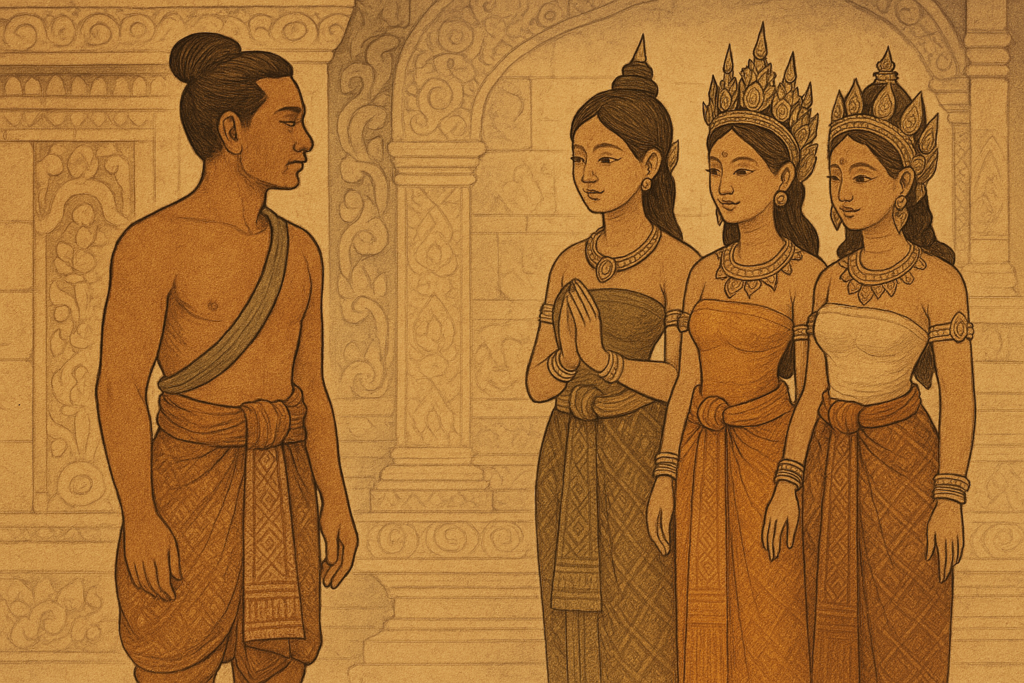
The history of the Sampot stretches back centuries, clearly visible in the detailed carvings of figures adorning the walls of ancient Angkorian temples like Angkor Wat and Bayon. These reliefs depict people from various social strata wearing wrapped lower garments similar to the Sampot, indicating its long-standing use. While sharing similarities with the Indian dhoti due to historical cultural exchange, the Sampot evolved distinct Khmer characteristics. Once common daily attire, its use gradually shifted over time, becoming more associated with court life, formal occasions, and eventually solidifying its role as the preeminent garment for ceremonies and cultural expression.
Varieties of Elegance: Types of Sampot
The term Sampot encompasses several distinct styles, varying in material, pattern, and method of wearing:
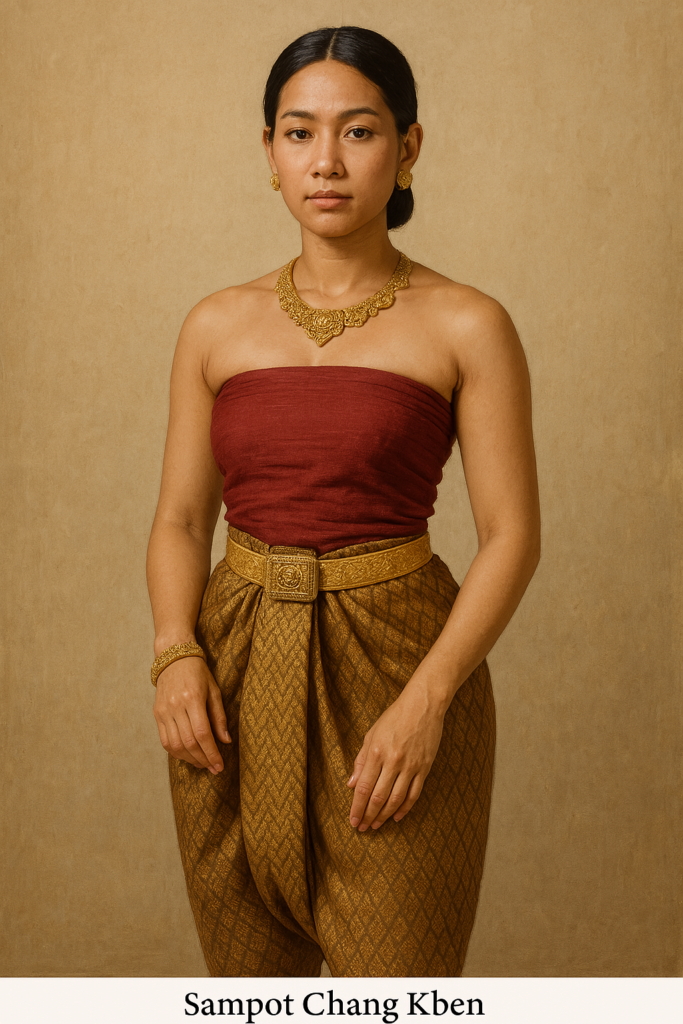
Sampot Chang Kben (សំពត់ចងក្បិន): This unique style involves a long piece of fabric (typically 3 meters long and 1 meter wide) wrapped around the waist like a skirt, then twisted into a fabric ‘tail’ at the front which is pulled between the legs and tucked into the waistband at the back, resembling trousers or pantaloons. Historically worn by royalty, officials, and soldiers of both sexes, it is now primarily seen during highly formal ceremonies, traditional dance performances, and as part of certain official uniforms. It requires specific fabrics, often high-quality silk, to drape correctly.

Sampot Hol (សំពត់ហូល): Considered one of the most prized and intricate forms, the Sampot Hol is characterized by complex patterns created using the traditional ikat weaving technique (known locally as chong kiet). In this laborious process, sections of the silk weft threads (and sometimes warp threads) are tie-dyed before weaving begins. When woven, these pre-dyed threads form intricate, slightly blurred motifs – geometric designs, flowers (like jasmine, lotus), animals (like birds, naga serpents), or other symbolic patterns. Primarily worn by women as a wrap-around skirt for significant events like weddings and religious ceremonies, its quality and complexity signify status and refinement. There are different types, such as Hol Lboeuk (featuring pictorial narratives) and Hol Por (smaller, repeating motifs).

Sampot Phamuong (សំពត់ផាមួង): This type generally refers to a range of woven silk fabrics, often featuring solid colors, stripes, or simpler geometric patterns compared to the Hol. Many Phamuong textiles use a twill weave, giving them a distinct texture. Produced in various qualities, Sampot Phamuong are commonly used by women for formal and ceremonial occasions, providing an elegant look without the extreme intricacy (and cost) of the Hol. Specific colors are sometimes traditionally associated with certain days of the week.

Sarong (សារ៉ុង): While technically a type of Sampot, the term Sarong often refers to simpler, everyday wrap-around skirts typically made of cotton or synthetic fabrics, worn casually by both men and women, especially at home or in rural settings.
Woven Meanings: Significance of Colors and Patterns
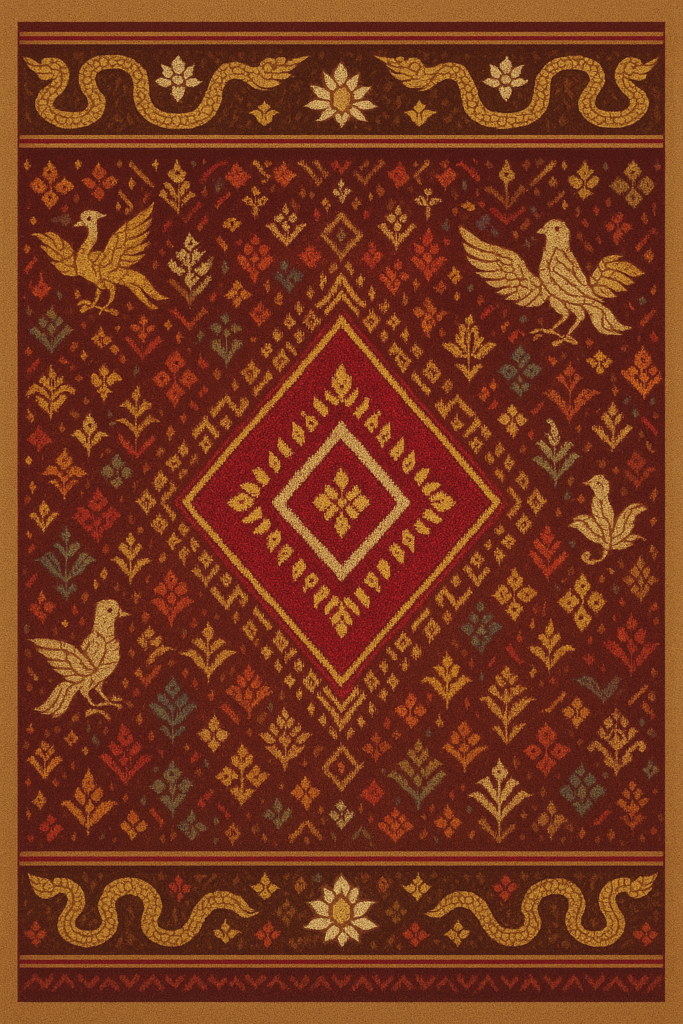
The designs woven into Sampots, especially the silk varieties, are rich with symbolism:
- Colors: Traditionally, certain colors held specific meanings or associations. Gold often signified royalty, specific colors might be designated for particular days of the week (a practice less common now but historically present), and black or white could be associated with mourning. The specific hues chosen for wedding Sampots also carry significance.
- Patterns: Motifs in Sampot Hol and Phamuong often draw from nature and mythology. Common elements include the protective Naga serpent, lotus or jasmine flowers symbolizing purity and Buddhism, diamond shapes, birds, and intricate geometric patterns that may represent stars or other cosmological elements. The patterns chosen can reflect the occasion, the wearer’s status, or regional traditions.
Gendered Styles: How Sampot Are Worn
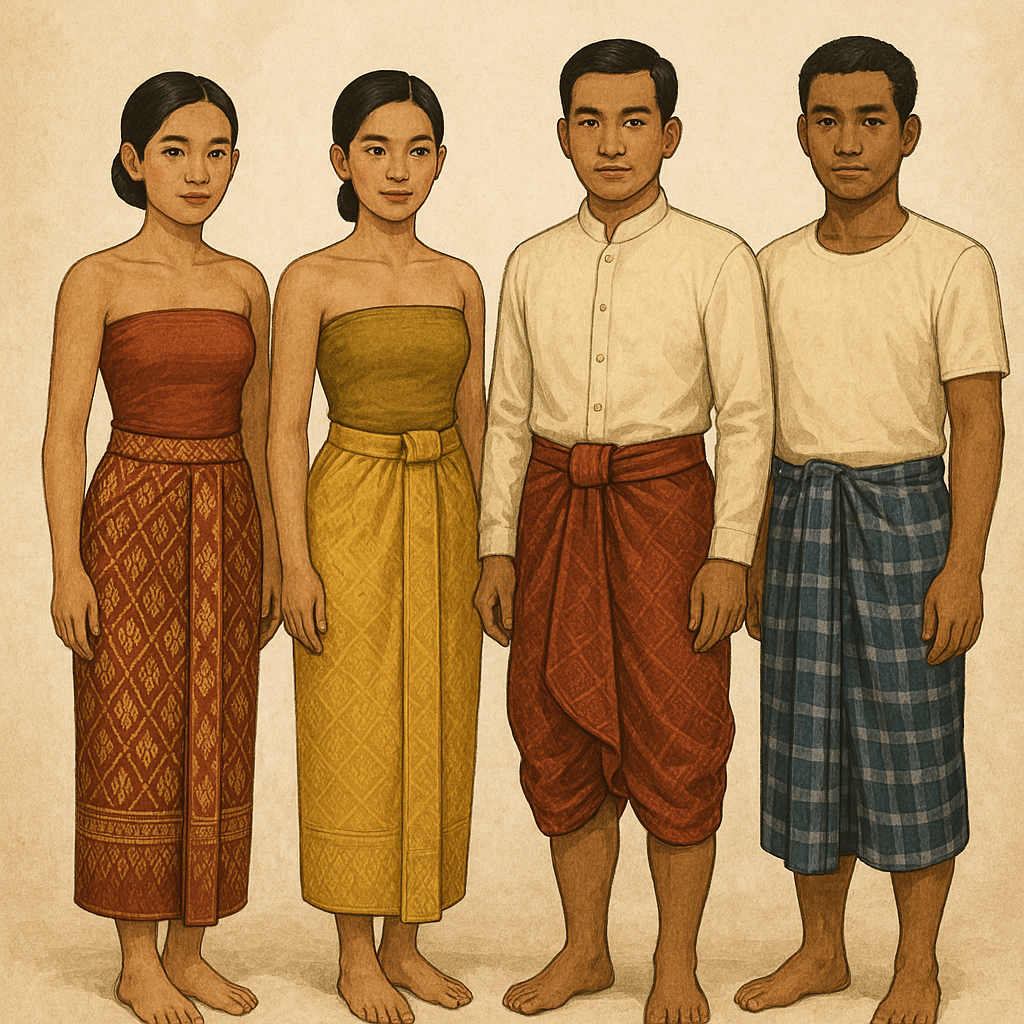
While both genders wear forms of Sampot, specific styles are more commonly associated with one or the other:
- Women: Primarily wear the wrap-around styles – Sampot Hol and Sampot Phamuong – for formal occasions. They also don the Sampot Chang Kben for classical dance performances or very high-level state functions.
- Men: Traditionally wore the Sampot Chang Kben for formal attire, court dress, or military uniforms. Today, men might wear it for very formal traditional weddings or historical reenactments. The simpler cotton Sarong is common for men’s casual wear at home.
From Past to Present: Sampot in Context
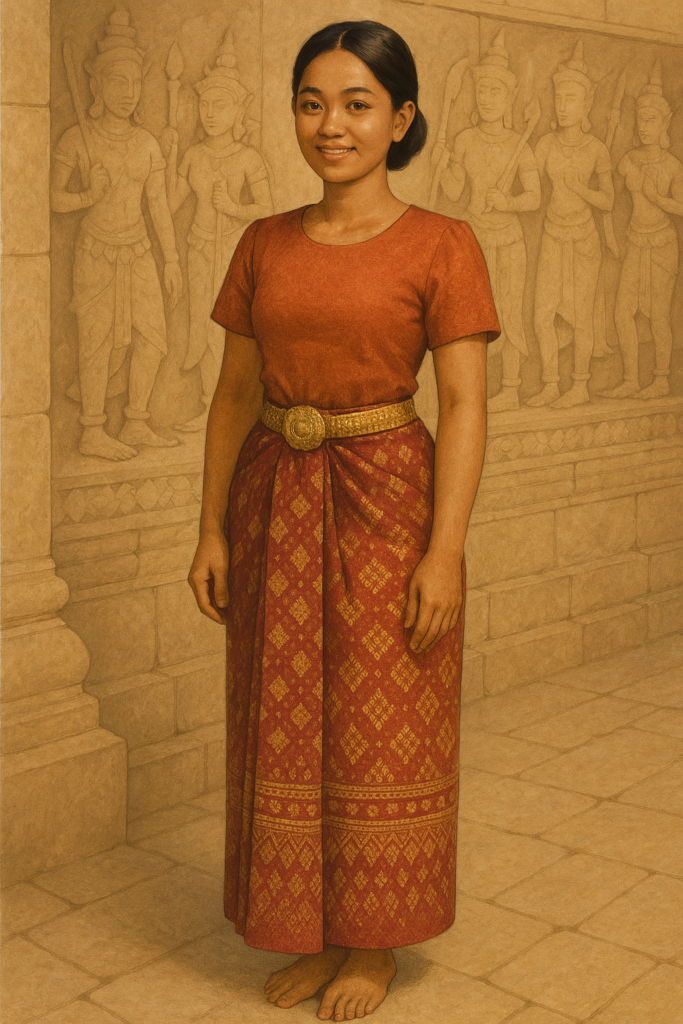
The role of the Sampot has evolved significantly:
- Historically: As depicted in ancient reliefs, Sampot-like garments were standard attire for many Cambodians, with material and complexity indicating social standing.
- Contemporary Usage: Today, the Sampot (especially silk varieties) is primarily reserved for special events. It is essential wear for weddings, major Buddhist holidays, national celebrations, formal receptions, and traditional arts performances. It also features in the uniforms of staff at the Royal Palace, some cultural institutions, traditional restaurants or hotels, and notably, the flight attendants of Cambodia Angkor Air, serving as a visible national symbol. Cultural revival movements also encourage wearing the Sampot to preserve heritage.
Ceremonial Centerpiece: The Role of the Sampot
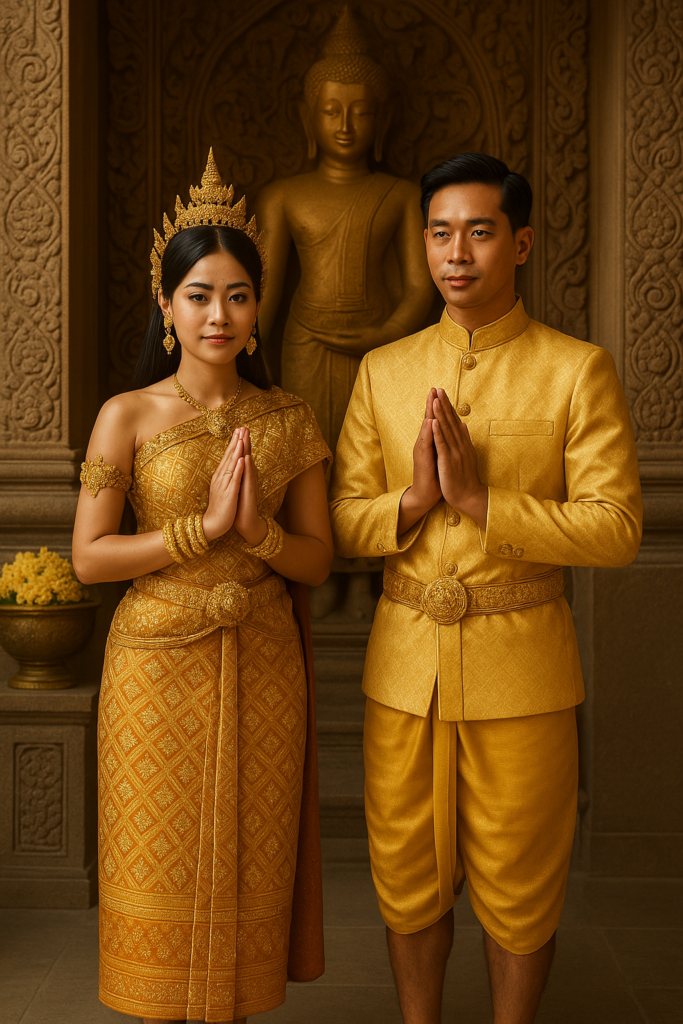
The Sampot holds an indispensable status in Cambodian ceremonies:
- Weddings: Perhaps the most visible occasion for Sampot wear. Brides and grooms typically wear multiple elaborate, matching Sampots throughout the traditional Khmer wedding ceremony, signifying the solemnity and cultural importance of the event.
- Religious Occasions: Cambodians often wear their finest Sampots, particularly Sampot Hol or Phamuong, when visiting pagodas to make merit during important Buddhist festivals like Pchum Ben (Ancestor’s Day) or Khmer New Year, showing respect.
- Cultural Performances: The Sampot is a defining element of costumes in classical Khmer dance, with Apsara dancers wearing ornately decorated versions.
- Formal Events: For state banquets or significant national events, wearing the appropriate Sampot is often expected as formal national dress.
Conclusion
The Sampot is more than just traditional clothing; it is a repository of Cambodian history, artistry, and cultural identity. From its depiction on ancient temple walls to its vibrant presence in modern ceremonies and cultural events in places like Battambang and beyond, the Sampot embodies Khmer elegance and tradition. Though its role has shifted from daily necessity to ceremonial significance, its enduring importance in marking life’s key moments and expressing national pride ensures its continued legacy in the heart of Cambodian culture.



